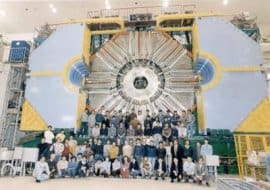
“Where has all the antimatter in the universe gone?” is one of the great unanswered questions in cosmology. Now, an unexpected difference in the behaviour of two types of exotic particle seen at an accelerator in Japan could help physicists understand why the universe is dominated by matter.
According to conventional cosmological models, equal amounts of matter and antimatter should have been created in the aftermath of the Big Bang. Matter and antimatter should have then annihilated, leaving only photons. However, the clear domination of matter in our visible universe indicates that our understanding of the physics of the early universe is incomplete.
One possible explanation for the dearth of antimatter was proposed by Makoto Kobayashi and Toshihide Maskawa in 1973. They suggested that the weak nuclear force — responsible for some types of radioactive decay — could act differently on matter and antimatter. This is asymmetry is thought contribute to what physicists refer to as charge–parity (CP) violation.
BaBar and Belle
The first observations of this Kobayashi–Masakawa (KM) asymmetry were reported 2002 and came out of studies of the decays of K and B mesons — short-lived sub-atomic particles consisting of quark–antiquark pairings and created by smashing electrons and positrons together. The measurements were made at both the Belle experiment at the KEK-B accelerator in Japan and at the BaBar experiment at the Stanford Linear Accelerator in the US.
However the asymmetry seen in these experiments is much too small to explain the elimination of antimatter from the universe.
Now, Belle scientists may have found the first inklings of where the rest of the asymmetry may be coming from — having observed an unexpected difference between the time it takes for charged and neutral versions of the B-meson to decay (Nature 452 332). The measurement was made over six years and involved the observation of some 535 million B mesons, which decayed into lighter subatomic particles called K and π mesons.
New physics
“This difference could be an indication of a new source of CP violation that is needed to explain the matter-dominated universe,” says Paoti Chang, a member of the Belle collaboration at National Taiwan University.
The result could be due to new types of short-lived unknown particles that are created as an intermediate step in the decay process, exacerbating the matter–antimatter imbalance. Alternatively, the effect could also be caused by interactions linked to another fundamental force — the strong nuclear force. However, if the latter is true, Chang points out that this may indicate a breakdown in our theoretical understanding of B meson decays.
“To understand whether new physics is indeed involved, study of CP violations from other modes of decay is needed,” says Chang. “Current experimental measurements on CP violation for these candidates are not precise enough, and much more data are needed.”
The researchers will be hoping future experiments such as the upcoming Large Hadron Collider and the Super B factory upgrade at KEK-B will help them find the reasons for the missing antimatter.



